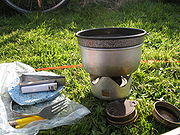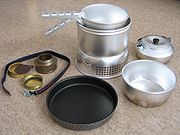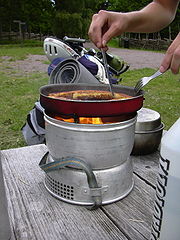
Trangia
Encyclopedia




Trademark
A trademark, trade mark, or trade-mark is a distinctive sign or indicator used by an individual, business organization, or other legal entity to identify that the products or services to consumers with which the trademark appears originate from a unique source, and to distinguish its products or...
for a line of alcohol
Alcohol
In chemistry, an alcohol is an organic compound in which the hydroxy functional group is bound to a carbon atom. In particular, this carbon center should be saturated, having single bonds to three other atoms....
-burning portable stove
Portable stove
A portable stove is a cooking stove specially designed to be portable and lightweight, as for camping or picnicking, or for use in remote locations where an easily transportable means of cooking or heating is needed...
s manufactured by Swedish
Sweden
Sweden , officially the Kingdom of Sweden , is a Nordic country on the Scandinavian Peninsula in Northern Europe. Sweden borders with Norway and Finland and is connected to Denmark by a bridge-tunnel across the Öresund....
company Trangia AB in Trångsviken
Trångsviken
Trångsviken is a locality situated in Alsen, Krokom Municipality, Jämtland County, Sweden with 269 inhabitants in 2005....
. These stoves are designed primarily for backpackers
Backpacking (wilderness)
Backpacking combines the activities of hiking and camping for an overnight stay in backcountry wilderness...
, with a focus on light weight, durability and simple design. First sold in 1925, Trangia stoves were initially preferred to kerosene (paraffin) pressure stoves because they required only one type of fuel (alcohol, usually in the form of methylated spirit
Methylated spirit
Denatured alcohol or methylated spirits is ethanol that has additives to make it more poisonous or unpalatable, and thus, undrinkable. In some cases it is also dyed....
). Trangia's unique selling point is that the entire packaged stove, including pots, is not significantly larger than a standard camp cooking pot. For this reason the Trangia has retained much of its popularity despite the development of alternative stove fuels and designs.
Components
The key component of a Trangia stove is the burner. This is a small brass cup that looks and functions similar to a beverage-can stoveBeverage-can stove
A beverage-can stove is a homemade, ultralight portable stove. The simple design is made entirely from aluminium cans and burns alcohol. Countless variations on the basic design exist....
. Fuel is poured into the burner and ignited. The heat from the flame causes the fuel to vaporize, forcing it out of 23 or 24 jets around the top of the burner, and producing a steady cooking flame. The burner includes a removable "simmer ring", which partially blocks the flame in order to reduce heat output. It also includes a sealed lid, so that extra fuel can be stored in the burner.
Alternative burners are available allowing to fuel the Trangia with gas cartridges or white gasoline.
In addition to the burner, the standard stove set includes a base, which lifts the burner off the ground and has vents to provide airflow, and a windscreen, which protects the pot and flame (the latter leading to its Swedish nickname, the "stormkök", or "storm kitchen"). The standard stove also includes two billycan
Billycan
A billycan, more commonly known simply as a billy or occasionally as a billy can , is a lightweight cooking pot which is used on a campfire or a camping stove.-Usage and etymology of the term:...
s (pots), a pot lid
Lid
LID is an abbreviation for:* Local light injection and detection, a method to determine fibre splice losses, especially in polarisation-maintaining fibre splicing...
/frying pan
Frying pan
A frying pan, frypan, or skillet is a flat-bottomed pan used for frying, searing, and browning foods. It is typically in diameter with relatively low sides that flare outwards, a long handle, and no lid. Larger pans may have a small grab handle opposite the main handle...
, an optional teakettle and a handle, commonly referred to as a Billy Grip
Billycan
A billycan, more commonly known simply as a billy or occasionally as a billy can , is a lightweight cooking pot which is used on a campfire or a camping stove.-Usage and etymology of the term:...
, used to grip onto the lip of the pots and pans. The entire set is designed to fit together in a single, portable package.
Types
The standard stove sets come in several variants, with varying sizes of pots, some with non-stick finishes. Some third party sets are also available, which typically include a Trangia burner and a lightweight base to support the burner and function as a pot stand. These tend to use fuel less efficiently, but are considerably lighter. The Trangia burner is also a component in the Swedish military mess kitMess kit
A mess kit is a collection of silverware and cookware used during camping and backpacking, as well as extended military campaigns.-Civilian camping mess kit:...
. The Finnish Defence Forces
Finnish Defence Forces
The Finnish Defence Forces are responsible for the defence of Finland. It is a cadre army of 15,000, of which 8,900 are professional soldiers , extended with conscripts and reservists such that the standard readiness strength is 34,700 people in uniform...
also use the Trangia, it's given to soldiers when needed so it's not part of the basic equipment.
There is also a Mini Trangia. This consists of a standard burner (with simmer ring), small wind shield, 800ml pot, 15cm frying pan and pot/pan grip (handle). The entire package weighs just 330 grams, according to Trangia's website. The Mini Trangia is much more portable than the standard-sized Trangia and is even lighter than most liquid-fuelled, pressure stoves (which don't include pots or pans in the weight). However, it is not as windproof as the full-size Trangias, and a self-made wind protector might be needed at an unsheltered and windy location.
Originally, Trangia stoves were made entirely from aluminium
Aluminium
Aluminium or aluminum is a silvery white member of the boron group of chemical elements. It has the symbol Al, and its atomic number is 13. It is not soluble in water under normal circumstances....
(except for the burner, which has always been brass
Brass
Brass is an alloy of copper and zinc; the proportions of zinc and copper can be varied to create a range of brasses with varying properties.In comparison, bronze is principally an alloy of copper and tin...
), in order to keep them lightweight. However, aluminum makes for a poor cooking surface, as food sticks to it, and it can add off-tastes to certain foods. Later, Trangia introduced Teflon-coated pots and pans. These are better for cooking, but wear out faster as the Teflon flakes off. More recently introduced is cookware made from titanium
Titanium
Titanium is a chemical element with the symbol Ti and atomic number 22. It has a low density and is a strong, lustrous, corrosion-resistant transition metal with a silver color....
, ultra-light aluminum, anodized ultra-light aluminum, and "Duossal" (a portmanteau of "duo", "stainless steel", and "aluminum"), which is aluminum with a stainless steel
Stainless steel
In metallurgy, stainless steel, also known as inox steel or inox from French "inoxydable", is defined as a steel alloy with a minimum of 10.5 or 11% chromium content by mass....
cooking surface. As of 2008, Duossal is no longer available.

